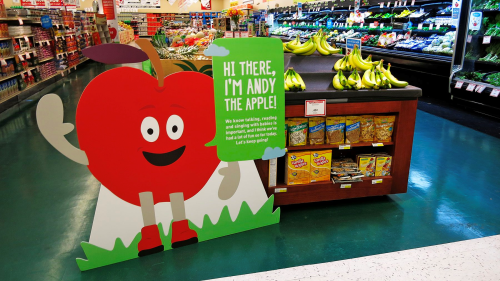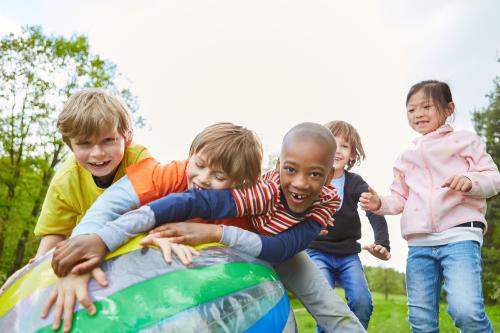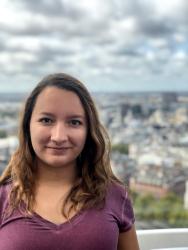As the urban population continues to grow globally, so too have disparities in economic opportunity and other indicators of well-being, including the availability of enriching social and learning experiences for children. The Playful Learning Landscapes (PLL) movement represents an evidence-based approach for addressing these inequities by providing new opportunities for learning in everyday public spaces where families spend time.
Interest in PLL has been growing in cities in the U.S. and abroad, but more support and guidance is needed to connect the research to on-the-ground practice and policy. In December 2020, the Brookings Center for Universal Education (CUE) and the Bass Center for Transformative Placemaking launched the PLL City Network to help address this need and create a community of practice for peer learning to support the uptake of playful learning approaches.
Through quarterly virtual meetings, network members have been building connections both within and between city teams to fully realize the potential benefits of PLL, discussing challenges and sharing strategies on how to infuse playful learning principles into the mainstream practices of government, businesses, and other organizations. The network launched with an initial cohort of four cities: Chicago, Philadelphia, Pittsburgh, and Tel Aviv, and later added Santa Ana, California and Lima, Peru. Conversations from recent network meetings have yielded several key insights that could help inform other local efforts to enhance playful learning opportunities in their communities:
1. PLL can materialize for different lengths of time—from seasonal or annual events to permanent installations.
PLL projects must be adapted to each community’s needs and available opportunities. This often means that the projects don’t always take the form of a permanent installation. The summertime, for instance, is a time of high-need for children—especially those living in low socioeconomic status (SES) neighborhoods who often aren’t able to participate in the same enriching extracurricular opportunities as their higher SES counterparts.
Philadelphia’s PlayParks are an example of summer programming targeted toward children living in low-income neighborhoods. A collaboration between different city actors and local organizations—including Tiny WPA and Black, Indigenous, and People of Color (BIPOC) businesses—PlayParks bring playful learning activities directly to the neighborhoods at set schedules.
Children participate in Philadelphia’s PlayParks activities.
Credit: Philadelphia Office of Children and Families
Similarly, Tel Aviv’s Play Streets provide seasonal, regularly scheduled playful learning, delivered to neighborhood streets via a Play Van. The project began in 2019 with a Playcar pilot, which brought 12 sessions of playful learning activities to parks and gardens in the city. “It was overwhelmingly successful, with more than one thousand children attending these sessions,” mentioned Dana Tennenbaum of Urban95 during a meeting last fall. Playcar’s success evolved into Play Streets and the team has recently created an implementation guide for community leaders in other parts of the city.
Children participate in Tel Aviv’s Play Streets with activities (below) delivered to them by the Play Van (above).
Credit: Urban95
While temporary or movable installations have the benefit of reaching a broad range of communities, permanent, well-maintained installations remain at the heart of the PLL movement. For example, in Santa Ana the Abacus Bus Stop emerged from an extensive community engagement process in which parents reflected on learning to count. Children and caregivers will be able to use the abacus to observe and tally things in their environment while waiting for the bus. The Chicago team created permanent math installations in North Lawndale and Douglass Boulevard. In Little Village, the team worked with local artists to paint murals in laundromats that highlight early math concepts and encourage child-caregiver interaction.
Design for Santa Ana’s Ababus Bus Stop—spearheaded by the city’s Public Works Agency.
Credit: University of California, Irvine
Chicago’s Laundromat Math installation in Little Village provides caregivers ample opportunity to engage with children while doing their laundry.
Credit: The McCormick Foundation
2. PLL events can build momentum and catalyze a city’s movement by sustaining collaborations throughout the year.
Behind the scenes, annual events can advance a city’s PLL movement beyond the events themselves. Pittsburgh’s Ultimate Play Day (UPD) brings togethers various actors—Trying Together, CitiParks, the Grable Foundation, and the Carnegie Museum of Art, among others—to plan an annual day of fun for families in the city. Motivated by a joint yearly goal, this unlikely group of partners keeps in regular contact such that their collaboration and impact is sustained beyond that single day. “[UPD] contributes to that continuous relationship building among a multi-sector set of organizations that then find cause and reason to advocate around play and playful initiatives…so it’s that play day that really holds together the coalition and drives all sorts of resulting actions,” shared Gregg Behr, executive director of the Grable Foundation.
Pittsburgh’s children and families enjoy playful learning activities on Ultimate Play Day.
Credit: Trying Together
3. PLL initiatives can reclaim public spaces for children and families, making safe play and playful learning more accessible.
Several cities in the network prioritize giving children and families safe spaces for play through PLL projects. For instance, Philadelphia’s Play Parks initiative works to reclaim public parks in the Kensington neighborhood, where violence and open drug usage are prevalent and children have few safe spaces for stimulating outdoor play. However, by clearly demarcating three parks for children and families through the use of regular scheduling, park ranger staff presence, and physical boundaries, Play Parks provides safe and enriching playful learning opportunities for Kensington’s children.
Children participate in Philadelphia’s PlayParks activities.
Credit: Philadelphia Office of Children and Families
Similarly, the Tel Aviv team noted that their Play Streets vision was “for play to occur in public spaces all over the city, in which streets closed for car traffic and became safe for children to play freely in them.”
Children participate in Tel Aviv’s Play Streets activities.
Credit: Urban95
Finally, Lima’s Urunaga Park is a permanent installation that rebuilt the park into an activities circuit for the local kids. Since the park was dangerous to access via local streets, the team created a new pedestrian crossing so that children from the local school had a safer passageway.
4. Public sector roles and responsibilities in facilitating PLL vary from city to city.
Designing and implementing PLL ideally involves public sector collaboration, but in practice this can vary. The public sector isn’t currently involved in all efforts. Lima’s efforts, for example, are exclusively led by Ocupa tu Calle, a nonprofit organization. Chicago has advocates in the Department of Transportation and the city’s Make Way for People Program, which oversees some of Chicago’s PLL initiatives, such as new math installations along Douglass Boulevard. However, many of Chicago’s efforts are primarily led by organizations like Enlace Chicago and Metropolitan Family Services. For Ultimate Play Day, the city of Pittsburgh’s CitiParks waives the permit fee every year and provides staffing support. And Santa Ana’s Abacus Bus Stop was spearheaded by the city’s Public Works Agency.
Some city governments are intimately involved in directing the PLL movement in their city. The city of Philadelphia, for example, created a specific role within the city government, dubbed the Playful Learning Fellow, which oversees PLL projects. Moreover, the city is often a main partner in such projects. For instance, Play Parks was brought to life by the William Penn Foundation and Philadelphia Parks and Recreation, and Parks and Rec functioned as the coordinating entity that engaged the many different partners.
Overall, these four takeaways are illustrative of the PLL movement’s adaptability to each city’s goals and context. Undoubtedly, there will be more lessons to share on playful learning as the PLL City Network continues to grow and evolve.
The Brookings Institution is a nonprofit organization devoted to independent research and policy solutions. Its mission is to conduct high-quality, independent research and, based on that research, to provide innovative, practical recommendations for policymakers and the public. The conclusions and recommendations of any Brookings publication are solely those of its author(s), and do not reflect the views of the Institution, its management, or its other scholars.
The William Penn Foundation and The Grable Foundation are donors to the Brookings Institution.
Brookings is committed to quality, independence, and impact in all of its work. Activities supported by its donors reflect this commitment.














Commentary
4 ways cities are embracing and promoting playful learning in their communities
February 3, 2023